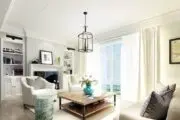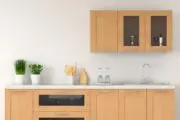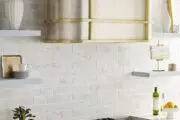From architectural features to furniture to decor, curves are among the top interior design trends for 2024. With a soft subtlety that guides the eye, what is it about curves in interior design that are so beguiling?
Biophilic design and the appeal of curved lines
The popularity of curves builds on another trending aesthetic: biophilic design. Biophilic design incorporates design and decor elements that occur in nature, with the idea that we are innately drawn to the comfort that these natural elements provide.
In the case of our built environment, hard, sharp angles are commonly seen and are manmade. Curved lines, however, occur organically in nature and are innately calming.
Think of the gentle spiral of a seashell, petals of a flower, edges of a cloud, raindrops, pebbles and so on.
In addition to replicating the peaceful experience of being immersed in nature, curves invoke calm because of the gentle, gradual visual that they deliver. Unlike hard angles and straight lines that can be abrupt and visually jarring, curved lines unfold and undulate.
One of the pillars of biophilic design is balancing the prospect/refuge dynamic, and curved lines fulfil this role nicely, particularly in an open-concept floor plan.
The idea of the prospect/refuge dynamic dates back to when we were hunters and gatherers. The concept hinges on the perfect harmony for a hunter/gatherer of being able to acquire food and other life necessities, while being provided an element of refuge for safety. To strike that balance, this must happen simultaneously.
On an innate level, curved lines offer this sensation. They pique curiosity visually, but also let the viewer ease into the aesthetic comfortably and cautiously.
Think of a curved wall in an open-concept floor plan. It offers some, but not complete division in the sight-line, and hints at what lies around the curve, without revealing it overtly.
Curved lines work well in a room where there are other hard angles, to introduce warmth, and create contrast.
Here are some ideas on bringing curves into your interior design.
Incorporating curves into architectural details
A curved wall is dramatic, and works well in a foyer, or within an open-concept area. A tip for hanging artwork on a curved wall: choose accents or artwork that mimic a similar shape and line quality to the curve presented in the wall, so it looks organic, as opposed to contrary to the line movement.
A popular custom feature among homeowners is curved archways for doorways. They are elegant and add visual interest without being obstructive to sight-lines. They are particularly effective when added in a room full of hard angles to introduce softness.
Including curved details in the ceiling will draw the eye up and contribute to a lofty feeling. A barrel-vaulted ceiling can make a room feel larger. Visually, a barrel-vaulted ceiling looks like a barrel cut in half. They add rustic, refined decor.
A coved ceiling introduces curved lines to where the ceiling meets the wall, which is typically a hard right angle. Creating a coved ceiling involves placing rounded drywall detail or molding at the junction of the wall and ceiling.
Simple curved beams on the ceiling add visual interest as well, and can signal transition between different rooms, particularly in an open floor plan.
Curved windows come in a variety of styles, including full circles, portholes, half-moon transoms, or ovals. Trending are arched windows, which pleasantly juxtapose the straight lines of a traditional rectangular window, with a rounded, arched top. A wall of arched windows in a dramatic black or gold trim creates an impressive focal point in a room.
A spiral staircase is a bold, curved style statement, whether made from metal, wood, glass, or plaster. It’s also a smart space-saving feature, as they work well in a small footprint, such as a condominium or loft.
Another clever way to incorporate curves into architectural features is with arched built-in bookcases and shelving storage units.
Curved furniture is everywhere
If curves are one of the hottest interior design trends in 2024, curved furniture is leading the trendline, with round nest chairs, curved armchairs and sofas, and rounded accent tables appearing everywhere.
Not sure about committing to fully rounded furniture? Choose a piece with rounded edges instead.
Curved furniture can be bulky, so space planning is important. Make sure you measure your space and the furniture, including the base. Consider placement of the curved piece in relation to the room and other pieces to ensure clearance and that the room doesn’t look stuffed.
Fabric choices matter with curved furniture. Love patterned textiles? It can be hard to match pattern lines within the curves on a piece of furniture. That’s part of the reason that textured fabric is so popular with curved furniture such as boucle or woven fabric.
Curves in kitchens and baths
Kitchens and bathrooms are typically full of hard, cold surfaces. The incorporation of curves can add warmth by cutting angles.
- Soften transitions between flooring types by incorporating a curved line, for example between hardwood in a family room into tile in the kitchen. Or choose tile with a circular pattern within the tile imprint.
- An oval-shaped kitchen island introduces a curved focal point. If there is in-island seating, choose circular stools.
- For countertops, choose a rounded profile. Consider a curved breakfast bar or peninsula extension.
- Cabinetry is often angular. Consider a curved end cabinetry unit, if space allows. For extra curved appeal, add fluting to the cabinetry.
- Opt for a custom, curved statement range hood.
- Round dining tables promote better conversation and are a space-saving solution in tighter spaces.
- Deep soaker tubs are a coveted spa-like feature in the bathroom. Opt for a curved profile over straight angles for a gentler look.
- Instead of an undermount sink in the bathroom, go for a large, round bowl sink.
- Choose circular showerheads and fixtures.
- Very popular are arched or circular mirrors hanging over vanity. Brass, gold and matte black make an elegant style statement.










